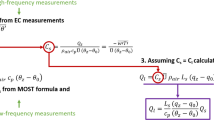Abstract
Lake ice cover is described by its thickness, temperature, stratigraphy and overlying snow layer. When the ratio of ice thickness to lake size is above ∼10−5, the ice cover is stable; otherwise, mechanical forcing breaks the ice cover, and ice drifting takes place with lead-opening and ridging. This transition enables a convenient distinction to be made between small and large lakes. The evolution of the ice cover on small lakes is solved by a wholly thermodynamic model, but a coupled mechanical–thermodynamic model is needed for large lakes. The latter indicates a wide distribution of ice thickness, and frazil ice may be formed in openings. Ecological conditions in large lakes differ markedly from those in small lakes because vertical mixing and oxygen renewal may take place during the ice season, and the euphotic zone penetrates well into the water column in thin ice regions. Mesoscale sea ice models are applicable to large lakes with only minor tuning of the key parameters. These model systems are presented and analysed using Lake Peipsi as an example. As the climate changes, the transition size between small and large lake ice cover will change.




Similar content being viewed by others
References
Abgeti, M. D. & J. P. Smol, 1995. Winter limnology: A comparison of physical, chemical and biological characteristics in two temperate lakes during ice cover. Hydrobiologia 304: 221–234.
Adrian, R., N. Walz, T. Hintze, S. Hoeg & R. Rusche, 1999. Effects of ice duration on plankton succession during spring in shallow polymictic lake. Freshwater Biology 41: 621–632.
Arst, H., A. Erm, M. Leppäranta & A. Reinart, 2006. Radiative characteristics of ice-covered fresh- and brackish-water bodies. Proceedings of the Estonian Academy of Science. Geology 55: 3–23.
Ashton, G. (ed.), 1986. River and Lake Ice Engineering. Water Resources Publications, Littleton, Colorado.
Bengtsson, L., 1996. Mixing in ice-covered lakes. Hydrobiologia 322: 91–97.
Burda, N. Yu., 1999. Computer simulation for Ladoga Lake ice dynamics based on remotely sensed data. International Geoscience and Remote Sensing Symposium 2: 937–939. Institute of Electrical and Electronics Engineers, New York.
Gerard, R., 1990. Hydrology of floating ice. In Prowse, T. D. & C. S. C. Ommanney (eds), Northern Hydrology. Canadian Perspectives. National Hydrology Research Institute, Saskatoon, Saskatchewan, 103–134.
Golosov, S., O. A. Maher, E. Schipunova, A. Terzhevik, G. Zdorovennova & G. Kirillin, 2006. Physical background of the development of oxygen depletion in ice-covered lakes. Oecologia (online). DOI: 10.1007/s00442-006-0543-8.
Hibler, W. D., III, 1979. A dynamic and thermodynamic sea ice model. Journal of Physical Oceanography 9: 815–846.
Järvinen, M., M. Rask, R. Ruuhijärvi & L. Arvola, 2002. Temporal coherence in water temperature and chemistry under the ice of boreal lakes (Finland). Water Resources 36: 3949–3956.
Leppäranta, M., 1983. A growth model for black ice, snow ice and snow thickness in subarctic basins. Nordic Hydrology 14: 59–70.
Leppäranta, M., 2004. The Drift of Sea Ice. Springer-Praxis, Heidelberg, Germany.
Leppäranta, M. & P. Kosloff, 2000. The thickness and structure of Lake Pääjärvi ice. Geophysica 36: 233–248.
Leppäranta, M & J. Uusikivi, 2002. The annual cycle of the Lake Pääjärvi ice. Lammi Notes 29: 4–9.
Saloranta, T., 2000. Modeling the evolution of snow, snow ice and ice in the Baltic Sea. Tellus 52A: 93–108.
Stefan, J., 1891. Über die Theorie der Eisbildung, insbesondere über Eisbildung im Polarmeere. Annales Physik, 3rd Series 42: 269–286.
Wake, A. & R. R. Rumer, 1983. Great lakes ice dynamics simulation. Journal of Waterway, Port, Coastal and Ocean Engineering 109: 86–102.
Wang, J., L. A. Mysak & R. G. Ingram, 1994. A numerical simulation of sea ice cover in Hudson Bay. Journal of Physical Oceanography 24: 2515–2533.
Wang, K., M. Leppäranta & T. Kõuts, 2003. A sea ice dynamics model for the Gulf of Riga. Proceedings of the Estonian Academy of Science. Engineering 9: 107–125.
Wang, K., M. Leppäranta & A. Reinart, 2006a. Modeling ice dynamics in Lake Peipsi. Internationale Vereinigung für theoretische und angewandte Limnologie 29: 1443–1446.
Wang, K., M. Leppäranta & T. Kõuts, 2006b. A study of sea ice dynamic events in a small bay. Cold Regions Science and Technology 45: 83–94.
Yen, Y.-C., 1981. Review of thermal properties of snow, ice and sea ice. CRREL Report 81–10: 1–27.
Acknowledgements
Financial support has been provided by the Academy of Finland, project “Hydrodynamic focusing of sediment oxygen consumption to the deepest parts of large lakes—a multidisciplinary approach” (Kalevi Salonen).
Author information
Authors and Affiliations
Corresponding author
Additional information
Guest editors: T. Nõges, R. Eckmann, K. Kangur, P. Nõges, A. Reinart, G. Roll, H. Simola & M. Viljanen
European Large Lakes—Ecosystem changes and their ecological and socioeconomic impacts
Rights and permissions
About this article
Cite this article
Leppäranta, M., Wang, K. The ice cover on small and large lakes: scaling analysis and mathematical modelling. Hydrobiologia 599, 183–189 (2008). https://doi.org/10.1007/s10750-007-9201-3
Published:
Issue Date:
DOI: https://doi.org/10.1007/s10750-007-9201-3




